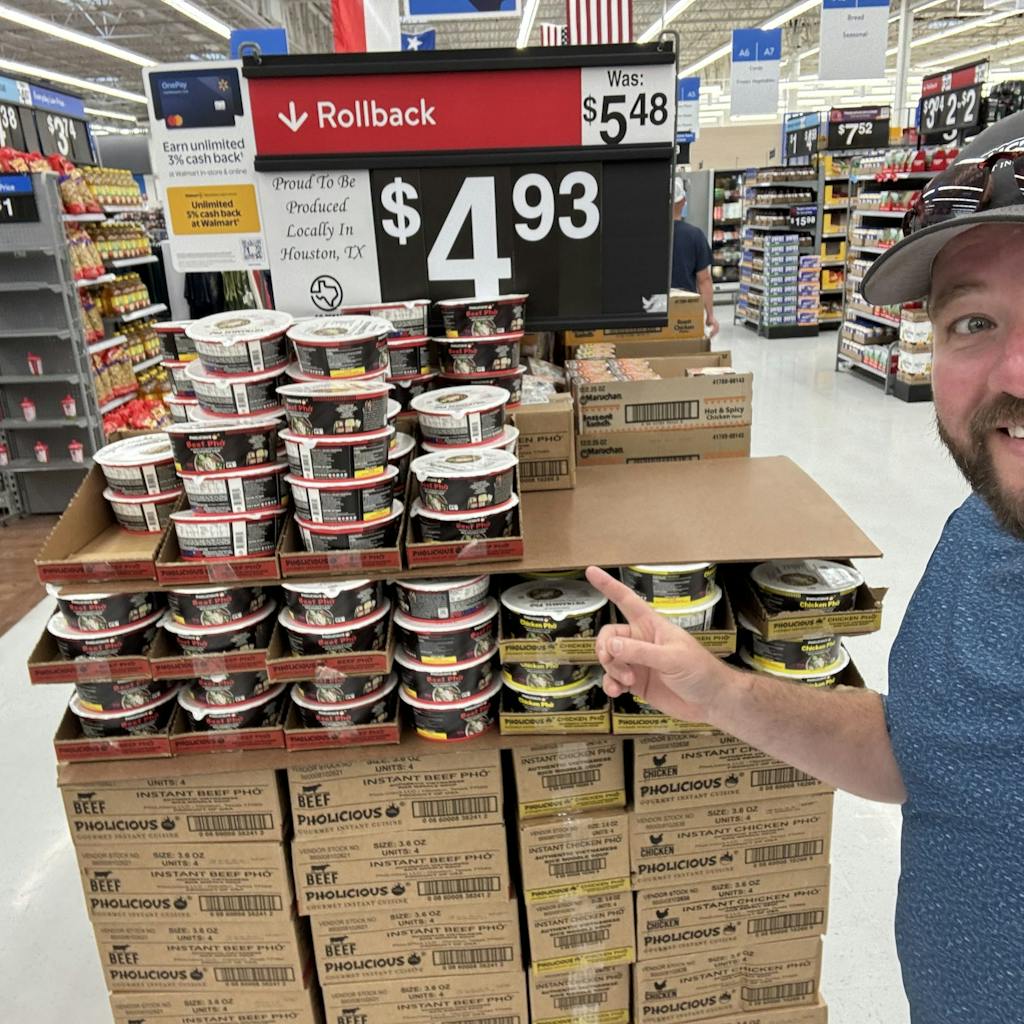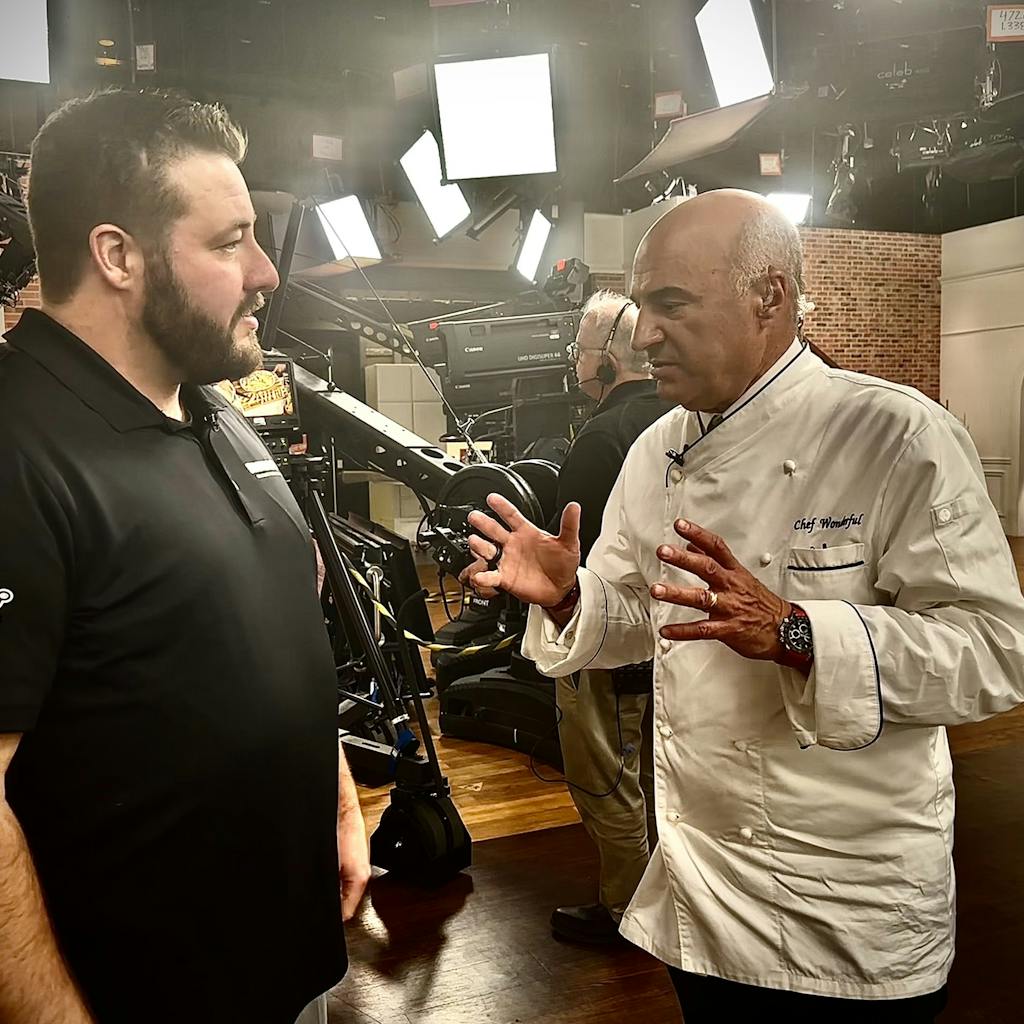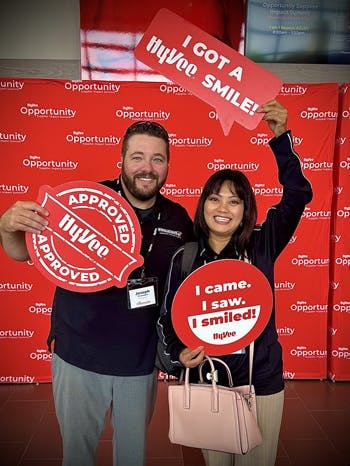The journey of a startup brand is rarely a straight line, but few stories showcase the power of persistence, flexibility, and proactive growth quite like that of Pholicious. When I first interviewed Co-Founder Joseph Trousdale in 2023, his brand was just starting his growth journey, having received a Golden Ticket at Walmart’s Open Call and wins with QVC and Sysco.
A LOT has changed since then.
The brand, which was launched by Trousdale and his wife Anh in 2021, makes authentic, quick-prep Vietnamese Pho (and now ramen), and since my last interview with Trousdale has added additional RangeMe wins including United Supermarkets, Stop & Shop, Albertsons and Kroger. And to top it off, they just received a Hy-Vee Smile just days before our interview at the retailer’s Opportunity Summit, one of RangeMe’s recent Immediate Opportunities.
To add a little cherry on top of the past two years of wins, Pholicious also landed on the shelves of H-E-B after winning the Quest for Texas Best contest, and a deal with Kevin O’Leary on Shark Tank. It’s been a busy two years indeed.
In my recent update interview with Trousdale (see the full video below), he recounts the rapid scaling of Pholicious, and below we unpack six vital lessons from his experience that every startup CPG brand would do well to follow.
1. Embrace buyer feedback as a path, not a rejection
Trousdale emphasizes that every interaction, even those that don’t result in an immediate shelf placement, provides a valuable roadmap for future success. “Just because you go to one of the events and don’t get an immediate yes, it’s great to soak up all the information because you can use that and turn that into a yes later. It’s usually if you don’t get a yes, that doesn’t mean no, it just means not right now, but there’s still always a path.”
Trousdale’s first Walmart Open Call experience is a perfect example: “Our first open call experience through RangeMe, we did not get a golden ticket,” he says. “But the conversation was like, ‘Hey, this is what you need to do. Get on Marketplace, let’s get on walmart.com, let’s see how it does.’”
By listening to the advice and staying in communication, they eventually secured placements in Sam’s Club and grew to over 1,900 Walmart locations.

2. Be adaptable to meet a retail buyer’s needs
Retailers often have unique tastes or requirements that may not align with a brand’s existing products. Being open to making adjustments is critical, even after securing a “yes” from a buyer.
Trousdale notes that a retailer may want a different product than the one originally pitched: “As an example, for Stop and Shop, which we connected with through RangeMe, we pitched our pho, which is our flagship product,” he says. “But we ended up launching a super spicy beef and chicken ramen.”
Similarly, Walmart is developing an exclusive, brand-new SKU with Pholicious only available at its stores. “It’s a conglomerate between everybody of how you evolve as a brand, how you evolve as a company, your customer feedback,” says Trousdale. “It’s always that ongoing communication that you want to keep open so you can evolve and improve as a brand and a product.”
3. Leverage retailer education to level up your operations
Many major retailers, including Hy-Vee, Walmart, and HEB, now incorporate extensive education for suppliers, covering everything from pitch preparation to in-store logistics and food safety. Brands should treat this education as a non-negotiable tool for growth.
For Pholicious, participating in HEB’s food safety education was transformative. It helped them write essential plans, leading to certifications and an efficient operation that impressed an FDA inspector.
“Following the inspection, the inspector asked, ‘How old is your company?’” says Trousdale. “She said that this is one of the cleanest facilities she’s seen in Texas, that our documentation’s on point, and we are operating like a 15 to 20-year-old company.”
Incidentally, it was also this H-E-B food safety education that led to the Trousedales going with Kevin O’Leary and rejecting the offer from KIND CEO Daniel Lubetsky when they pitched on Season 16 of Shark Tank.
“Daniel said that he was going to bring in a team of 30 people to help us out with food safety,” says Trousdale. “And while they didn’t air the part, we went through what we did with H-E-B and and in our heads we’re like, we really don’t need that team of 30 to come into our manufacturing facility. We need help with social media, with branding, and getting out to retailers. Kevin hit on all those points.”

4. Master data reporting to sustain growth and protect sales
Once on shelves, a brand’s work has just begun. Proactively monitoring sales data and inventory is essential to prevent costly out-of-stocks and potential delisting. Walmart, for example, provides suppliers with tools like Scintilla (its internal reporting system) to access critical sales, inventory, and supply chain data.
One case in particular demonstrates the powerful effectiveness of Scintilla. Using the reporting system, Trousdale’s team identified an issue where 20 stores were showing “zero sales” and “zero on shelf” despite having stock listed as “in stock” in the back. By investigating and reaching out to the store managers, they corrected the issue and turned those locations into some of their top sellers.
“If we never did that or never did reporting, those stores would’ve just consistently showed zero and Walmart would’ve just pulled those stores,” says Trousdale. “Now some of those stores are some of our top sellers. So reporting is super huge on that.”
5. Foster an environment that encourages staff feedback and ownership
In a fast-growing manufacturing environment, your employees are often the best source of operational innovation. Pholicious actively encourages its team to share ideas, which led to significant warehouse and production efficiencies.
Case-in-point: Some team members who had worked at other warehouses suggested stacking and organization techniques that could be helpful, which Pholicious immediately implemented. This input helped them maximize their storage space and allowed them to make crucial decisions about automation and utilizing their talent in more valuable roles.
“Our employees saw that we would take their advice, and it makes them feel that we value them and their input,” says Trousdale. “Then more employees start to say, ‘Hey, I saw this over here. I saw this at this company,’ and we’ve just sort of evolved as an entire team.”
6. Be proactive and strategic with RangeMe submissions
In his early days, Trousdale would submit broadly to buyers on RangeMe without understanding their specific needs or timing. Now however, he advises a highly focused approach to maximize your chances of success.

He learned to prioritize submissions to Immediate Opportunities, as these indicate a retailer is actively looking for a product in that category. In addition, he says that checking the Category Review schedule is also essential, as buyers focus their attention during these periods. Finally, he recommends becoming RangeMe Verified, as it adds a layer of credibility that signals to buyers the brand is prepared for retail business.
“For me it was definitely worth going the Verified route because then companies know,you have all of your stuff in order, like insurance,” says Trousdale. .
Pholicious’s tremendous growth, which now includes a 52,000 square foot warehouse, developing robotic automation, and even television advertising with one of Kevin O’Leary’s platforms, proves that success in the CPG world is a combination of a great product and a dedication to relentless learning and execution.
But wait… there’s more!
While these are some key insights from our full conversation, we covered a lot more ground in our interview, so I highly recommend that you check out the full video below, or listen to the interview on Episode 19 of our podcast, Winning Pitches with RangeMe & ECRM!

